Nissan Maxima Service and Repair Manual: Periodic maintenance
REAR SUSPENSION ASSEMBLY
On-vehicle Service
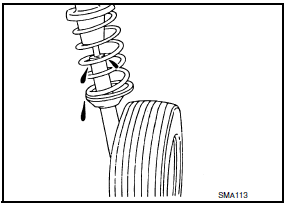
- Check the suspension parts for excessive play, cracks, wear or damage. Shake each rear wheel to check for excessive play.
- Retighten all nuts and bolts to the specified torque.
- Make sure that the cotter pin is installed.
- Check the rear shock absorber for oil leakage or other damage.
- Check the wheelarch height. Refer to FSU-19, "Wheelarch Height (Unladen*1)".
- Check the suspension ball joint for grease leakage and the ball joint dust cover for cracks or other damage.
Inspection
REAR SHOCK ABSORBER
- Check for uneven operation through a full stroke for both compression and extension. Replace if necessary
- Check for oil leakage on the welded or gland packing portions. Replace if necessary.
- Check the rear shock absorber for deformation, cracks, or other damage. Replace if necessary.
- Check the piston rod for damage, uneven wear, and distortion. Replace if necessary.
REAR SUSPENSION ARM
- Check the rear suspension arm for damage, cracks, and deformation. Replace if necessary.
- Check the arm bushing stoppers for damage, cracks and deformation. Replace the rear suspension arm if necessary.
- Check the ball joint. Replace the rear suspension arm if any of the following conditions exist:
- The ball stud is worn.
- The swinging force (A) is out of specification.
- The turning force (B) is out of specification.
- The vertical end play (C) is out of specification.
NOTE: Before checking specifications, turn the ball joint at least 10 revolutions so the ball joint is properly broken in.
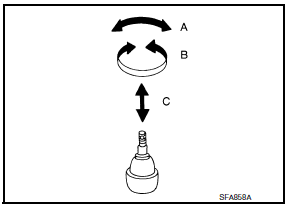
RADIUS ROD
- Check the radius rod for any deformation, cracks, or damage. Replace if necessary.
- After installing the radius rod, check the wheel alignment and adjust if necessary. Refer to RSU-6, "Inspection and Adjustment".
FRONT LOWER LINK
- Check the front lower link for any deformation, cracks, or damage. Replace if necessary.
REAR SPRING UPPER AND LOWER RUBBER SEATS
- Check the rear spring upper and lower rubber seats for deterioration, or cracks. Replace if necessary.
REAR LOWER LINK AND REAR SUSPENSION SPRING
- Check the rear lower link and the rear suspension spring for any
deformation, cracks, or other damage.
Replace if necessary.
REAR STABILIZER
- Check the rear stabilizer and the rear stabilizer clamps for any deformation, cracks, or damage. Replace if necessary.
- Check the rear stabilizer bushings for deterioration or cracks. Replace if necessary.
Inspection and Adjustment
Before checking the rear wheel alignment, make a preliminary inspection.
- Measure the wheel alignment under unladen conditions.
NOTE: Unladen conditions mean that fuel, engine coolant, and lubricants are full. That the spare tire, jack, hand tools, and mats are in their designated positions.
PRELIMINARY INSPECTION
- Check the tires for wear and for improper inflation.
- Check the wheels for deformation, cracks, and other damage. Remove the wheel and check the wheel runout. Refer to WT-58, "Inspection".
- Check the rear wheel bearings for looseness.
- Check the rear suspension for looseness.
- Check that the rear shock absorbers work properly.
- Check the wheelarch height in the unladen condition. Refer to FSU-19, "Wheelarch Height (Unladen*1)"
GENERAL INFORMATION AND RECOMMENDATIONS
- A Four-Wheel Thrust Alignment should be performed.
- This type of alignment is recommended for any NISSAN vehicle.
- The four-wheel "thrust" process helps ensure that the vehicle is properly aligned and the steering wheel is centered.
- The alignment machine itself should be capable of accepting any NISSAN vehicle.
- The alignment machine should be checked to ensure that it is level.
- Make sure the alignment machine is properly calibrated.
- Your alignment machine should be regularly calibrated in order to give correct information.
- Check with the manufacturer of your specific alignment machine for their recommended Service/Calibration Schedule.
THE ALIGNMENT PROCESS
IMPORTANT: Use only the alignment specifications listed in this Service Manual. Refer to FSU-19, "Wheelarch Height (Unladen*1)".
- When displaying the alignment settings, many alignment machines use "indicators": (Green/red, plus or minus, Go/No Go). Do NOT use these indicators.
- The alignment specifications programmed into your alignment machine that operate these indicators may not be correct.
- This may result in an ERROR.
- Most camera-type alignment machines are equipped with both "Rolling Compensation" method and optional "Jacking Compensation" method to "compensate" the alignment targets or head units. "Rolling Compensation" is the preferred method.
- If using the "Rolling Compensation" method, after installing the alignment targets or head units, push or pull on the rear wheel to move the vehicle. Do not push or pull on the vehicle body.
- If using the "Jacking Compensation" method, after installing the alignment targets or head units, raise the vehicle and rotate the wheels 1/2 turn both ways. NOTE: Do not use the "Rolling Compensation" method if you are using sensor-type alignment equipment.
- Follow all instructions for the alignment machine you are using for more information.
CAMBER
- Measure the camber of both the right and left wheels using a suitable alignment gauge and adjust using the following procedure.
- If the camber is not within specification, adjust the camber by turning the adjusting bolts in the same direction.
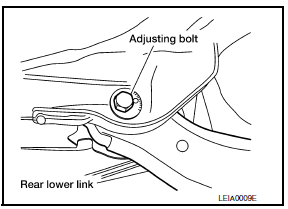
- Turn the adjusting bolts in the same direction to calibrate.
NOTE: Camber changes about 5' with each graduation of the adjusting bolt.
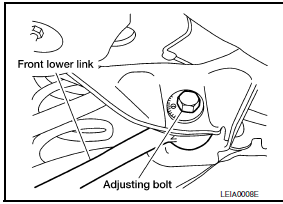
- Tighten the adjusting bolt nuts to the specified torque.
TOE-IN
- Measure the toe-in of the rear wheels. If out of specification, inspect and replace any damaged or worn rear suspension parts before adjusting.
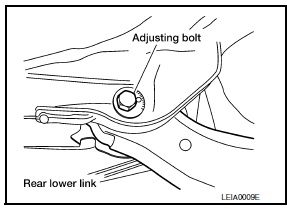
- Adjust toe-in by turning adjusting bolt on rear lower link.
NOTE: Toe changes about 1.5 mm (0.059 in) [one side] with each graduation of the adjusting bolt.
- After adjusting, tighten the adjusting bolt nut to the specified torque.
 Symptom diagnosis
Symptom diagnosis
NOISE, VIBRATION AND HARSHNESS (NVH) TROUBLESHOOTING
NVH Troubleshooting Chart
Use the chart below to help you find the cause of the symptom. If necessary,
repair or replace these parts.
&tim ...
Other materials:
B2615 front blower motor relay circuit
Description
BCM controls the various electrical components and simultaneously supplies
power according to the power
supply position.
BCM checks the power supply position internally.
DTC Logic
DTC DETECTION LOGIC
DTC CONFIRMATION PROCEDURE
1. PERFORM DTC CONFIRMATION PROCEDURE
Tur ...
P0102, P0103 MAF sensor
Description
The mass air flow sensor (1) is placed in the stream of intake air. It
measures the intake flow rate by measuring a part of the entire
intake flow. The mass air flow sensor controls the temperature of the
hot wire to a certain amount. The heat generated by the hot wire is
re ...
Active trace control
The Integrated Dynamics-control Module is an
electric control module that includes the following
functions:
Active Trace Control
Active Engine Brake
Active Ride Control
This system senses driving based on the driver's
steering and acceleration/braking patterns, and
controls brake pres ...
Nissan Maxima Owners Manual
- Illustrated table of contents
- Safety-Seats, seat belts and supplemental restraint system
- Instruments and controls
- Pre-driving checks and adjustments
- Monitor, climate, audio, phone and voice recognition systems
- Starting and driving
- In case of emergency
- Appearance and care
- Do-it-yourself
- Maintenance and schedules
- Technical and consumer information
Nissan Maxima Service and Repair Manual
0.006

